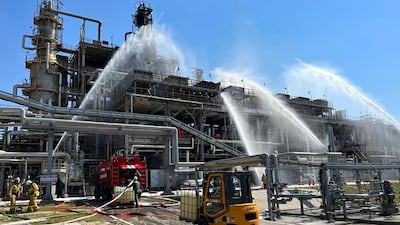A barrage of Ukrainian rockets launched at Russian oil production sites shows the ability of a new generation of missiles.
Kyiv recently demonstrated domestically made missiles such as the Flamingo, which has a range of 3,000km, and the Neptune, which can travel 300km.
The result was a series of attacks that created new problems for Russia. There are now questions over Washington’s opinion of the strikes.
The missile and drone attacks have cut Russian fuel supplies to Hungary and Slovakia – the only European countries that import Moscow’s oil – whose leaders have complained to US President Donald Trump.
But Washington has continued to sell long-range missiles to Ukraine, through European countries, with reports that 3,350 Extended Range A Missiles will be made available within six weeks.

In the past month, there have been attacks on 10 energy plants that have disrupted 17 per cent of Russia's refinery capacity, or 1.1 million barrels a day.
Analysts told The National that the attacks demonstrate Ukraine still has “leverage” in any peace talks, as attacks on Russian crude production could affect global oil prices.
Ukrainian influence
Ukraine has shown that it can directly affect foreign markets, after launching a strike on Friday against a key pumping station on the Druzhba oil pipeline that carries fuel to Europe.
Viktor Orban, Hungary’s pro-Russian Prime Minister, condemned Kyiv on social media for a “very unfriendly move”. He added that his country wishes “President Trump every success in his pursuit for peace”.
Mr Orban posted a picture on Facebook showing a handwritten note from Mr Trump. It said: “Viktor – I do not like hearing this – I am very angry about it.”
But the strikes showed that Ukraine “has leverage to take into negotiations, showing the ability to strike deep into Russia and that it has an economic impact on Russia”, said Timothy Ash, Russia specialist at the Chatham House think tank.
The tactic also allows Kyiv to challenge suggestions that it is losing the war. But such attacks will only have a global impact if Ukraine damages Russia’s crude export capacity.
“This is a sweet spot of hurting Russians at home and not actually putting downward pressure on global crude oil prices, which is beneficial to Trump,” Mr Ash said. “Anything Ukraine did to impact on global markets and energy prices would not make Mr Trump very happy.”

Russian fuel crisis
The strikes appeared to intensify at the weekend, with targets hit in the Leningrad region including the Novatek gas processing complex – the largest producer of liquefied natural gas in Russia.
On Sunday, the Syzran oil refinery in the Samara region was hit. The site refines up to 8.5 million tonnes of oil a year, which is equal to three per cent of Russia’s total refining output.
The long-range attack affected the country’s fuel reserves and threatened oil revenue, reported Kommersant, a Russian business news outlet. Such income is key to the Kremlin’s ability to pay its soldiers high wages to fight on the front lines.
Kommersant also reported that Russia was on the brink of a fuel crisis because wholesale prices have surged this month, with production down by nearly 10 per cent since January.
In some cases, fuel prices have risen by 49 per cent, with shortages leading to long queues at petrol stations. The problem has pushed the Kremlin to introduce an export ban into at least October.
Repairs at the refinery could take months to complete, especially with international sanctions making it difficult to import the right equipment.
“The Kremlin's inability to effectively navigate critical energy sector issues challenges Russia's ongoing narrative that it is capable of withstanding western economic pressures and financing its war effort for the long term,” the Institute for the Study of War think tank said.
Russia relies on oil and gas exports for a quarter of its budget revenue, which has funded a 25 per cent rise in defence spending. Despite Mr Trump’s attempts to secure a peace deal, the war has continued unabated this week, with Russia also launching attacks on Ukrainian cities.



